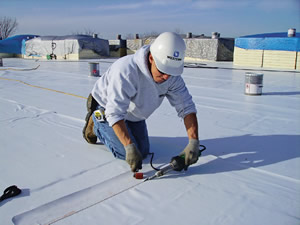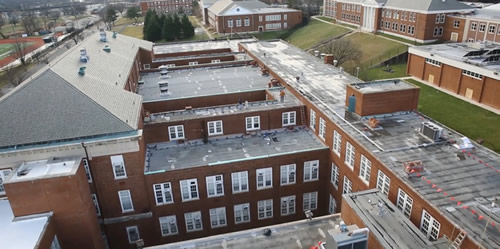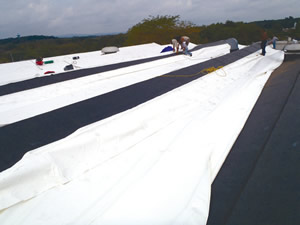My Roof's Got a Hole In it...

PHOTO COURTESY OF WESTERN SPECIALTY CONTRACTORS
The only slam-dunk reroofing projects are those in which the leaks have gotten so bad that even a light drizzle fills the buckets in the rooms beneath. In those cases, the decision to reroof is a no-brainer, and the occupants are so glad to have someone finally paying attention to their chronic roof leaks that they buy doughnuts for the roofing crew every morning. So why is reroofing so difficult?
Because few, if any, reroofing projects in your career as a facilities professional or school administrator will be that easy.
Collect the Data
Build the case for the roof work by accumulating data. The age of the roof is certainly one point to consider, but not the only one. Gather the maintenance logs that demonstrate situations that require attention every time it rains and don’t dismiss a physical inspection of the roof being considered. To the extent possible document the problems with photos. When it is not possible to access the roof and see the problems, use technology to document the issues. Bluefin LLC roofing consultant used a drone to inspect and identify potential failures on a steeply pitched slate roof in the Washington, D.C. Public Schools. When in doubt about the moisture content of the substrate, most roofing consultants recommend taking samples and/or doing an infrared scan.
Make the Critical Decisions
Schedule is important for keeping staff, parents, and students happy and safe. Among the many decisions you must make are whether or not to reroof while the building is occupied. Almost nobody goes swimming outdoors in the dead of winter and only a handful of districts schedule major roof work outside of the summer hiatus. Noise, noxious odors, and the many distractions that come with staging substantial supplies one, two, or sometimes three stories in the air make for work during the seemingly less expensive times of the year still prohibitive. Several years ago, an elementary school in Anne Arundel County, Md., was evacuated for a week after staff and students complained of the odors. This is not uncommon when trying to reroof when the building is occupied.
Next, you must decide what roofing material you are going to specify. Many districts have a preferred roofing system that they use for the majority of their work. This is often based upon good long-term experience with the product and/or good customer service from the available installers. Other districts use a more site-specific approach. In these cases, the materials selected may vary widely depending upon the problem to be solved. A fluid-applied membrane might be used where useable life can be extended, or a completely new system might be used where the old membrane has failed and the wet insulation must be removed.

PHOTO COURTESY OF BLUEFINN, LLC
The next roofing decision is determining the scope of the work. Some districts put roofs that are 20 years old on a list for replacement as part of their preventive maintenance protocol. Others simply replace the entire roof once the leaks start, since it will only be a matter of time before the rest of the roof fails. Still other districts will do partial replacements and/or useable life extension where they feel there are portions of a roof that are still in good condition or can be made such with some attention.
Roofs fail in many ways. Clearly, identifying the cause of the failure is in everyone’s best interest. If the existing roof is a sheet product (EPDM, PVC, or TPO), there are three likely suspects—the edges, the seams, or the penetrations. Since sheet products tend to shrink over time, the flashing at the edges might be under strain. As the product gets older and more brittle, the seams will also tend to fail. And even new roofs can have problems at the penetrations—curbs, caps, pitch pockets, roofing boots, drains, and scuppers. All are potential leak sites. Since built-up modified bitumen roofs consist of several layers of material stuck together, the failure usually occurs at a location where all layers fail. This is often easy to see with a close visual inspection. Of course, there are times when even a built-up roof conceals its failures.
Always check the insulation under the roof for moisture. But remember there are other sources of unwanted moisture inside a building. Every pipe that carries liquid or gas at a temperature that is significantly different than the conditioned temperature inside the building should be insulated. When an uninsulated internal roof leader drips condensation, the wet spot on the acoustical tile ceiling looks exactly like a roof leak.
Collateral Damage
Chronic roof leaks can cause collateral damage, particularly if they are undetected over a long period of time. Soggy insulation on top of galvanized metal deck or concrete deck may not be a problem, but if it is in contact with cementitious wood fiber decking it could be. Some fiber decking materials may not be able to withstand prolonged moisture exposure.

PHOTO COURTESY OF DURO-LAST
Moisture in walls as a result of roof leaks can causes mold and mildew. Moisture inside of gypsum board walls is particularly destructive, since even moisture resistant wallboard tends to fall apart with repeated exposure. Once a reroof occurs, test the walls in the vicinity of the old leaks for moisture content and the need for mold and/or mildew cleanup.
Most of the floor coverings in a school are installed to withstand heavy traffic. As a result, they tend to resist water damage, if the water is removed in a timely fashion with a wet/dry vacuum. Wood flooring is the single exception to this rule of thumb. Water that is allowed to soak into a wood floor causes the wood to expand and as a result it will create substantial hills and valleys in the surface that are nearly impossible to reverse or repair. Wood gymnasium floors can be ruined if exposed to repeated roof leaks.
Several years ago, a creative technology company decided that they could provide a school system with a better solution by installing thermocouples under the insulation at regular intervals on the roof. The idea was that should a roof leak occur, the facilities personnel would be notified immediately and could take action to repair the leak. Further damage would be avoided. Trouble is, most districts were afraid they would not be able to respond to all of the “alarms” that would occur. Roof leak response in many organizations is simply not that finely tuned.
Communicate
As always, a lack of communication can turn a sound technical project into a failure. There are many constituents who must be given detailed information about the project well in advance, including administration, staff, students, parents, and the public. Seek their input and adjust the logistics of the project accordingly. While your purpose may be to fix the roof, you will also be judged by how little your project disrupts normal operations at the school. Thorough communications are the key to that.
This article originally appeared in the School Planning & Management April/May 2019 issue of Spaces4Learning.